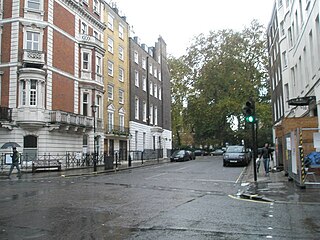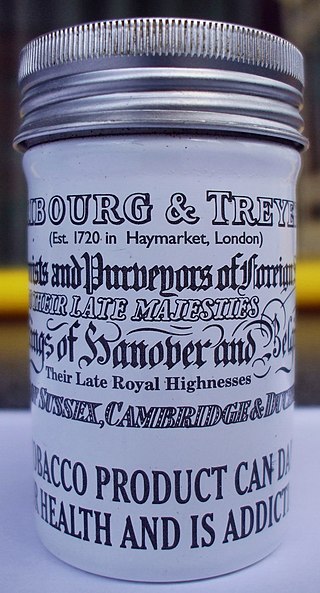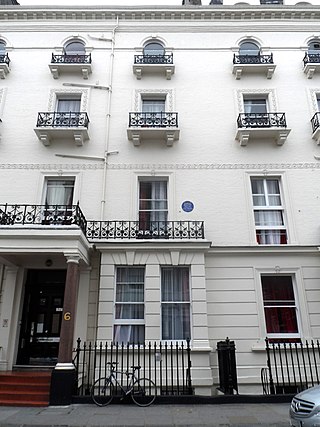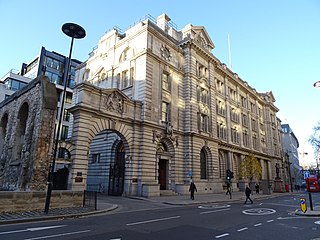Clerkenwell Bridewell was a prison and correctional institute for prostitutes and vagrants located in the Clerkenwell area, immediately north of the City of London, between c. 1615 and 1794. It was named 'Bridewell' after the Bridewell Palace, which during the 16th century had become one of the City of London's most important prisons.
Fauconberg House was a house in Soho Square in the City of Westminster, London. It was demolished in 1924.

Hinde Street is a street in the Marylebone district of the City of Westminster, London, that contains the Hinde Street Methodist Church and was home to the novelist Rose Macaulay until her death.

Gottlieb Augustus Treyer (1790–1869) was a Holy Roman Empire-born British snuff manufacturer and retailer.

Fribourg & Treyer was a British snuff and tobacco manufacturer and retailer. It was founded by Mr Fribourg in 1720 at 34 Haymarket, London. They were famous for retailing Turkish tobacco. The business became Fribourg & Treyer, after the German-born Gottlieb Treyer married Mrs Martha Evans whose family had already entered into the business. They sold cigars and snuff and cigarettes. Up to 1820, ninety per cent of the sales was snuff and only ten per cent tobacco. It was then fashionable to keep different snuffs for different times of day, and some fastidious people kept a special room for storing them. A very fine Adam screen of about 1750, still containing much of the original glass, divides the old part of the shop from the expansion at the back. In 1912 33 Haymarket was added to the premises when Burberry's relocated.

Edmund Alexander Spurr was a British architect who designed and was the superintendent of the Great Northern Cemetery in London, England. He was a fellow of the Royal Institute of British Architects. Spurr is buried at New Southgate Cemetery.

Clarges Street is a street in the City of Westminster, London. The street runs from Clarges Mews in the north to Piccadilly in the south. It is crossed by Curzon Street.

Mayfair Place is a street in the City of Westminster, London. The street joins Stratton Street to Berkeley Street.

Maiden Lane is a street in Covent Garden, London, that runs from Bedford Street in the west to Southampton Street in the east. The painter J. M. W. Turner was born on this street in 1775.

The Cheshire Cheese is a public house at 5 Little Essex Street, London WC2, on the corner with Milford Lane.

The Edgar Wallace is a public house at 40–41 Essex Street, London WC2, at the corner with Devereux Court.

Highbury New Park is a street in Highbury in the London Borough of Islington which runs from Highbury Quadrant in the north to Highbury Grove in the south.

Devereux Court, a street in the City of Westminster located just south of the Strand and east of Essex Street, is completely pedestrianised. This narrow lane is lined with well-preserved seventeenth-century buildings. The court's distinctive dog-leg layout has remained unchanged since its establishment in the 1670s on the grounds of Essex House, a stately home renowned for its expansive gardens.

The Finchley Meeting House is a Friends meeting house at 58 Alexandra Grove in Finchley, London N12.

Grenville Place is a street in the Royal Borough of Kensington and Chelsea, London, that connects Cornwall Gardens and Launceston Place in the north with Cromwell Road in the south. It is crossed in its northern part by Cornwall Mews South, and joined on its western side by Emperor's Gate (twice). it is joined on its eastern side by Southwell Gardens.

Lawrence Lane is a street in the City of London that runs from Trump Street in the south to Gresham Street in the north. Its final section in the north is pedestrianised. An alley also joins it to King Street in the north. It once ran south to join Cheapside but that end was blocked following post-Second World War rebuilding. It was known as St Lawrence Lane from the 13th to the 18th centuries due to its proximity to the church of St Lawrence Jewry and until King Street was built was the main route from Cheapside to the London Guildhall.

King Edward Street is a street in the City of London that runs from Newgate Street in the south to Little Britain in the north. It is joined by Greyfriars Passage in the west and Angel Street in the east. Postman's Park is on its east side where Bull and Mouth Street once lay and joined King Edward Street.

Honey Lane Market was an historic market near Cheapside in the City of London.

Chepstow Place is a street in London that runs from the junction of Westbourne Grove and Pembridge Villas in the north to Pembridge Square in the south. It is crossed by Dawson Place and joined on its eastern side by Rede Place. The east side is in the City of Westminster and the west side in the Royal Borough of Kensington and Chelsea.

Markham Square is a garden square in Chelsea, London. It was laid out in 1836. The square is accessed from the King's Road.




















